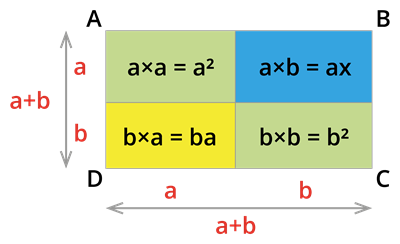UPSKILL MATH PLUS
Learn Mathematics through our AI based learning portal with the support of our Academic Experts!
Learn moreIdentity 2:

By observing the above rectangle, we can notice that:
\text{Area of the bigger square = Area of the two small square + Area of the two rectangles}
3 + 22 + 3 = (3 × 3) + (2 × 3) + (3 × 3) + (2 × 2)
Now, we simplify the LHS and RHS of the above expression.
LHS = 3 + 22 + 3 = 5×5 = 25
RHS = (3 × 3) + (2 × 3) + (3 × 3) + (2 × 2)
= = 9+6+6+4 = 25
Therefore, LHS = RHS
Similarly, if we use the variables in this case instead of number we get:

Assume the square of ABCD of side a + b. From the above figure, we can get that:
\text{The total area of the bigger square = The area of the two small squares × The are of the two rectangles}
That is, (a + b)^2
Since, ba=ab; (a + b)^2 .
Therefore, is a identity.
Example:
Simplify the expression using the identity .
Now write the given expression with respect to the given identity .
Now simplify the expression.
.
Therefore, .